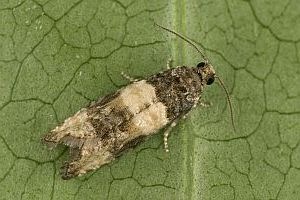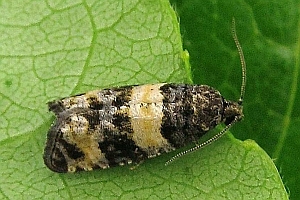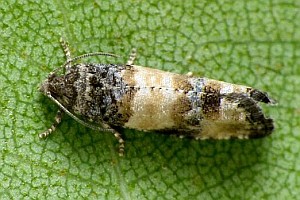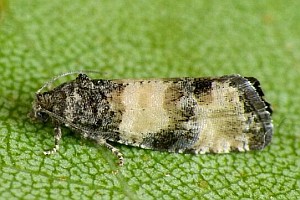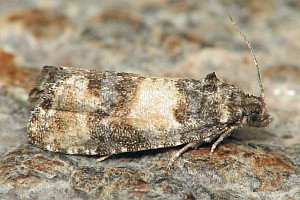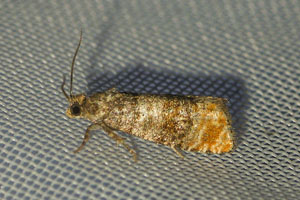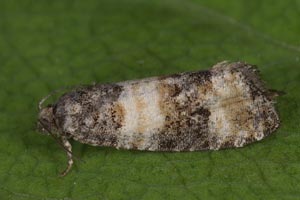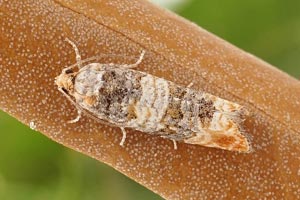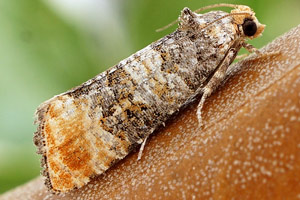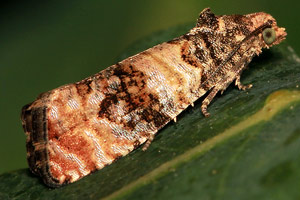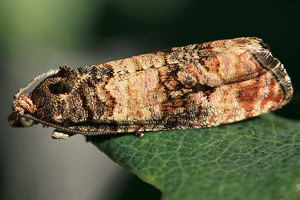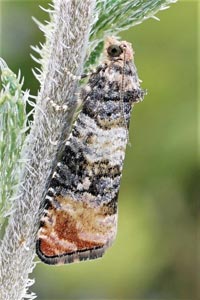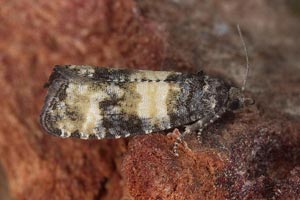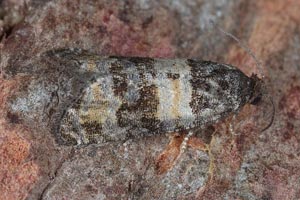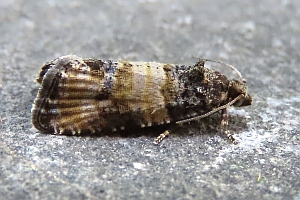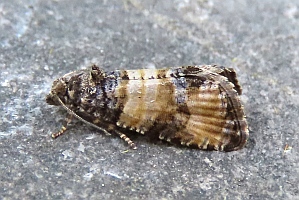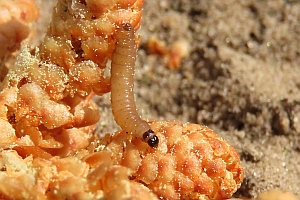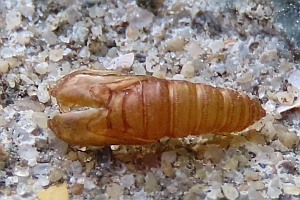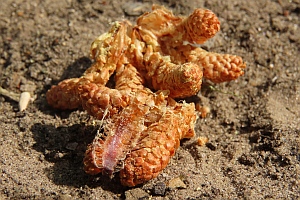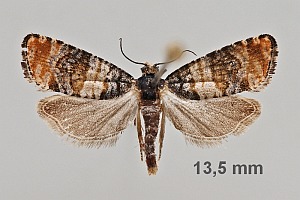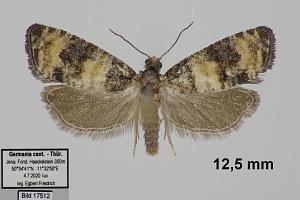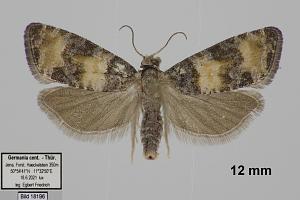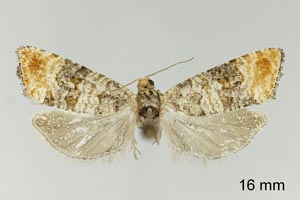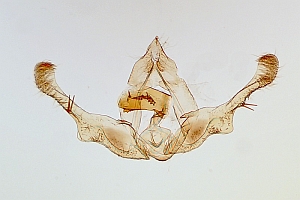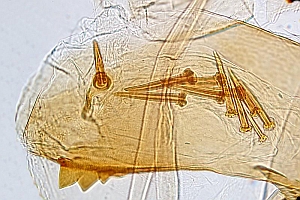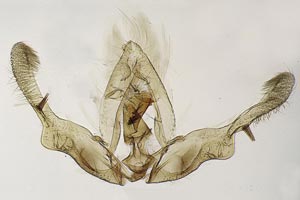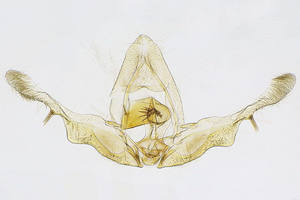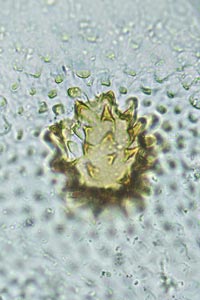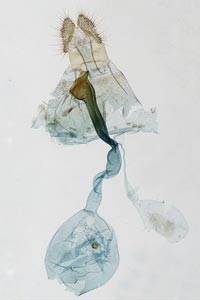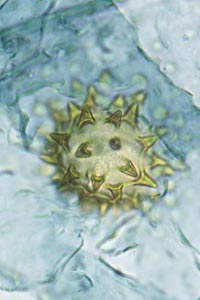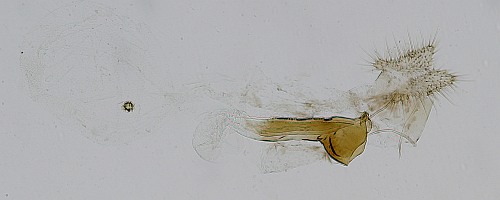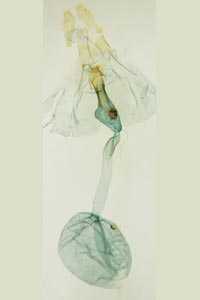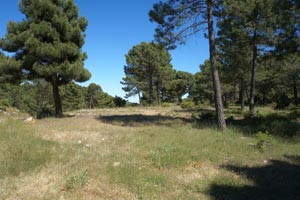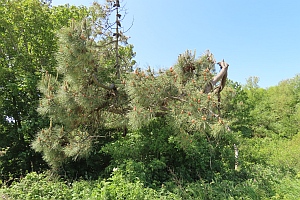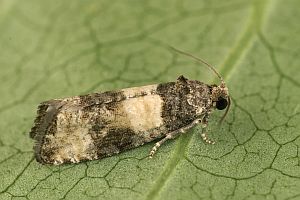
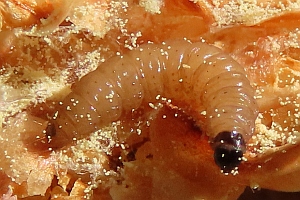
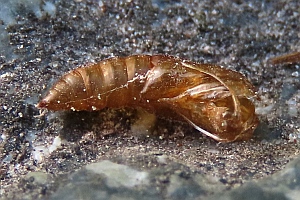
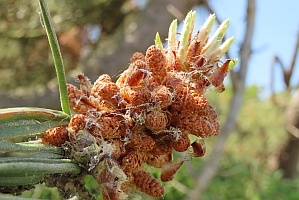
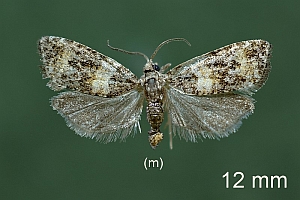
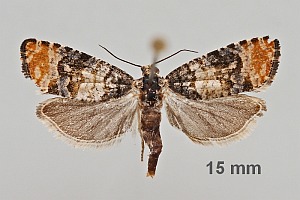
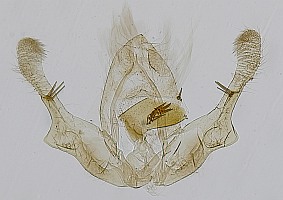
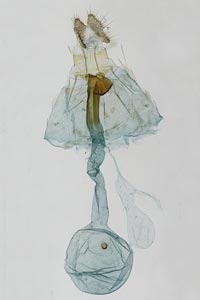
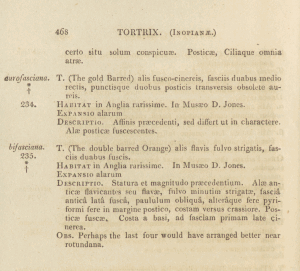
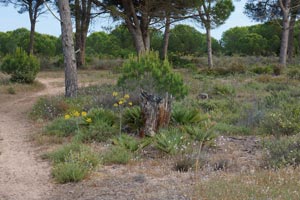
1. Lebendfotos
1.1. Falter
1.2. Raupe
1.3. Puppe, Exuvie
1.4. Fraßspuren und Befallsbild
2. Diagnose
2.1. Männchen
2.2. Weibchen
2.3. Genitalien
2.3.1. Männchen
Wichtiger Hinweis: Männliche Genitalien:
Agassiz (2002: 153) stellt in seiner Buchbesprechung von Razowski (2001) alle von diversen Experten in jenem Buch erkannten Fehlbestimmungen / Bildvertauschungen in einer Tabelle zusammen. Demnach wurden dort S. 136 die Abbildungen der männlichen Genitalien von Nr. 256 Piniphila bifasciana und Nr. 255 Pseudohermenias abietana miteinander vertauscht.
2.3.2. Weibchen
2.4. Erstbeschreibung
3. Biologie
3.1. Habitat
3.2. Nahrung der Raupe
- [Pinaceae:] Pinus sylvestris (Wald-Kiefer)
- [Pinaceae:] Pinus pinaster (Strand-Kiefer, See-Kiefer)
- [Pinaceae:] Pinus halepensis ? (Aleppo-Kiefer ?)
Bankes (1909: 199) beschrieb die Raupe im Detail. Dazu vermerkte er: "The larva, in my experience, lives among and feeds on the male catkins of Pinus pinaster, joining together into a loosely spun mass, and living in a neat gallery lined with white silk, which it constructs, near the central stem, among the bases of the individual catkins.The dry pellets of frass are buff-yellow, and from their colour and appearence it seems to me probable that the pollen forms the principal food of the larva, though it also eats the scales of which the catkin is composed."
Schütze (1931: 450) handelte die Art unter Pinus - Kiefer" ab und dort unter der Zwischenüberschrift "In und zwischen Nadeln:". Konkret schrieb er zur Art: "Raupe Mai [...] Nach Disqué soll die Raupe in den männlichen Blüten leben".
Bei Disqué (1905: 229) hieß es konkret: "R. lebt gegen Ende Mai in den männlichen Kiefernblüten. Sie ist hellgrau mit fast schwarzem Kopf und dunkelbraunem Nacken- und Afterschild."
Razowski (2001: 63) passt dazu: "L V-VI [...] männliche Bl[üten], Tr[iebe]; Pinus sylvestris u.a. (Pinaceae)."
Etwas mehr Informationen - aber nichts Neues - gibt es bei Hancock et al. (2015: 35): Ovum. Laid in July on a shoot of Scots pine (pinus sylvestris) or maritime pin (Pinus pinaster). It is not known, when the eggs hatch. Larva. Head dark brown or black. Body yellowish to pale grey, sometimes tinged with red; pinacula and peritreme of spiracles darker than integument; prothoragic plate brown to blackish, medial sulcus whitish; thoragic legs brownish black; anal plate brown. May-June; feeds in young shoots and amongst male flowers of pine; the blossom is spun into a loose mass in which a silk-lined gallery is constructed near the base of the central stem (Bankes, 1909c)."
Die genaue Quelle zur Angabe "Pinus halepensis" bei [bladmineerders.nl] ist mir noch nicht bekannt. Die Angabe dürfte aber vermutlich stimmen.
(Autor: Erwin Rennwald)
4. Weitere Informationen
4.1. Andere Kombinationen
- Tortrix bifasciana Haworth, 1811 [Originalkombination]
4.2. Synonyme
- Piniphila bicinctana Tengström, 1848
- Piniphila decrepitanus (Herrich-Schäffer, 1851)
4.3. Publikationsjahr der Erstbeschreibung
Wir übernehmen hier die von Heppner (1982) angegebenen Publikationsjahre.
4.4. Literatur
- Agassiz, D. (2002): Book Review Razowski, J. 2001. Die Tortriciden (Lepidoptera, Tortricidae) Mitteleuropas. — Nota Lepidopterologica, 25 (2/3): 152-154. [Digitalisat auf biodiversitylibrary.org]
- Bankes, E.R. (1909): Notes on the live history of Olethreutes (Sericornis) bifasciana Hw. with descriptions of the larva and pupa. — The Entomologist's monthly Magazin, 45: 198-201.
- Disqué, H. (1905): Die Tortriciden-Raupen der Pfalz. — Deutsche Entomologische Zeitschrift "Iris" 17: 209-256. [PDF auf zobodat.at]
- Hancock, E.F., Bland, K.P. & J. Razowski (2015): The moths and butterflies of Great Britain and Ireland. Volume 5 (Part 2). Tortricidae, Olethreutinae. - 377 S.; Leiden & Boston (Brill).
- Erstbeschreibung: Haworth, A. H. (1803-1828): Lepidoptera britannica; sistens digestionem novam insectorum lepidopterorum quæ in Magna Britannia reperiuntur, larvarum pabulo, temporeque pascendi; expansione alarum; mensibusque volandi; synonymis atque locis observationibusque variis: I-XXXVI, 1-609. Londini (R. Taylor).
- Heppner, J. B. (1982): Dates of selected Lepidoptera literature for the western hemisphere fauna. — Journal of the Lepidopterologists' Society 36 (2): 87-111.
- Razowski, J. (2001): Die Tortriciden (Lepidoptera, Tortricidae) Mitteleuropas. Bestimmung - Verbreitung - Flugstandort - Lebensweise der Raupen. — 319 S.; Bratislava.
- [SCHÜTZE (1931): 40]



![Vorkommen in Österreich [Huemer (2013: NR 2532)]](/res/img/flag/at.png)

![Vorkommen in Norwegen (außer Spitzbergen und Jan Mayen) [Aarvik & al. (2017): Nordic-Baltic Checklist]](/res/img/flag/no.gif)
![Vorkommen in Dänemark (außer Färöer-Inseln und Grönland) [Aarvik & al. (2017): Nordic-Baltic Checklist]](/res/img/flag/dk.gif)
![Vorkommen in Schweden [Aarvik & al. (2017): Nordic-Baltic Checklist]](/res/img/flag/se.gif)
![Vorkommen in Finnland (außer Åland-Inseln) [Aarvik & al. (2017): Nordic-Baltic Checklist]](/res/img/flag/fi.gif)
![Vorkommen in Russland (europäischer Teil bis Manytsch-Niederung) [Sinev (2021)]](/res/img/flag/ru.gif)
![Vorkommen in der Ukraine (ohne Halbinsel Krim) [Karolinskiy, Demyanenko, Guglya, Zhakov, Kavurka & Mushinskiy (2018)]](/res/img/flag/ua.gif)
![Vorkommen auf der Krim [Sinev (2021)]](/res/img/flag/ua-kri.gif)
![Vorkommen in Weißrussland [Pisanenko, A., Švitra, G. & V. Piskunov (2019): Checklist of Lepidoptera recorded from Belarus]](/res/img/flag/by.gif)
![Vorkommen in Estland [Aarvik & al. (2017): Nordic-Baltic Checklist]](/res/img/flag/ee.gif)
![Vorkommen in Lettland [Aarvik & al. (2017): Nordic-Baltic Checklist]](/res/img/flag/lv.gif)
![Vorkommen in Litauen [Aarvik & al. (2017): Nordic-Baltic Checklist]](/res/img/flag/lt.gif)
![Vorkommen in Polen [Buszko J. & J. Nowacki [eds] (2017): A Distributional Checklist of the Lepidoptera of Poland]](/res/img/flag/pl.gif)
![Vorkommen in Tschechien [Laštůvka, Z. & J. Liška (2011): Komentovaný seznam motýlů České republiky]](/res/img/flag/cz.gif)

![Vorkommen in Ungarn [Pastorális et. al. (2018): A Magyarországon előforduló molylepke-fajok névjegyzéke]](/res/img/flag/hu.gif)
![Vorkommen in Großbritannien [Agassiz, Beavan & Heckford (2013): Checklist of the Lepidoptera of the British Isles]](/res/img/flag/gb.gif)
![Vorkommen in Irland einschließlich Nordirland [Bond & O'Connor (2012): Checklist of Irish Species]](/res/img/flag/ie.gif)
![Vorkommen in Belgien [De Prins(2016): Catalogus van de Belgische Lepidoptera]](/res/img/flag/be.gif)
![Vorkommen in den Niederlanden [Kuchlein & de Vos (1999): Annotated Checklist of the Dutch Lepidoptera]](/res/img/flag/nl.gif)
![Vorkommen in Luxemburg [Hellers (2002): Die Wickler Luxemburgs]](/res/img/flag/lu.gif)
![Vorkommen in Frankreich (europäisches Territorium ohne Korsika) [Vandromme et al. (2020): Liste systématique et taxinomique des Lépidoptères de France]](/res/img/flag/fr.gif)
![Vorkommen auf Korsika [Vandromme et al. (2020): Liste systématique et taxinomique des Lépidoptères de France]](/res/img/flag/fr-cor.png)
![Vorkommen in Monaco [Lemaire & Billi (2018)]](/res/img/flag/mc.gif)
![Vorkommen in Spanien (Festland) [Vives Moreno A. (2014)]](/res/img/flag/es.gif)
![Vorkommen in Portugal (Festland) [Corley (2015): Lepidoptera of Continental Portugal]](/res/img/flag/pt.gif)
![Vorkommen in Italien (Festland und kleine festlandsnahe Inseln) [Trematerra (1995): Checklist delle Specie della Fauna Italiana 85]](/res/img/flag/it.gif)
![Vorkommen in Slowenien [Lesar & Govedič (2010): Check list of Slovenian Microlepidoptera]](/res/img/flag/si.gif)
![Vorkommen in Kroatien [Gomboc, Kirichenko, Sule & Zadravec (2024: 288)]](/res/img/flag/hr.gif)
![Vorkommen in Serbien [Jakšić (2016): Tentative Checklist of Serbian microlepidoptera]](/res/img/flag/rs.gif)
![Vorkommen in Rumänien [Rákosy L. & M. Goia (2021): Lepidopterle din România: lista sistematică şi distribuţie]](/res/img/flag/ro.gif)
![Vorkommen im asiatischen Teil der Türkei [Koçak & Kemal (2018)]](/res/img/flag/tr.gif)
